Embodied Symbols of the South Seas: Eastern Oceania
Article © 2010 Lars Krutak
Easter Island
Twenty-five hundred miles to the southeast of Hawaii lies the island of Rapa Nui or Easter Island. On Easter Sunday, 1722, the Dutch navigator Jacob Roggeveen was cruising the vastness of the South Pacific when he first sighted a small volcanic island in the distance. Landing at a rocky cove, his crew marveled at colossal seven-meter high stone statues (moai) standing in silent rows along the shore. Perhaps at that moment his men began to wonder just who lived in this mysterious place cut off from the entire world. It seemed that Easter Island had developed in complete isolation for centuries.
The Easter Islanders, who today refer to themselves and to their homeland as Rapa Nui, are the easternmost of some thirty-six Polynesian peoples whose ancestors discovered and settled the islands of the central and eastern Pacific. They share a common ancestry with other Polynesians, such as the Hawaiians, Tahitians, and the New Zealand Maori, and their tattooing traditions retain particular features that link them to other Austronesian speakers of Melanesia.
The ancestors of the Polynesians began to migrate from Melanesia and Southeast Asia around 1500 B.C. and by 600-800 A.D. they arrived on Easter Island. According to Rapa Nuilegend, the island was settled by Hotu Matu’a, a powerful chieftain who arrived with a group of colonists in two large sailing vessels. At this time, dense palm forests and stands of small trees covered the island, and the coasts were visited by seabirds, sea turtles, and marine mammals. Over time, however, the trees were cut and by the close of the nineteenth-century, Rapa Nuiwas virtually a barren landscape. |
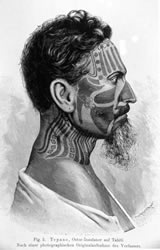 |
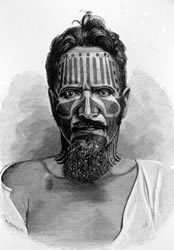
|
Profile and portrait view of Juan Tepano, 1880s. |
Down through the centuries, a distinctive form of art developed on the island blending anthropomorphic and zoomorphic imagery into superbly crafted and almost surrealistic forms. The power of this aesthetic tradition revolved around perceptions of life experienced in an unforgiving insular environment, one devoid of trees and land mammals (except perhaps for one lizard species), which led Rapa Nuiartisans to focus their energies completely and entirely on the few fragments of wood they could find.
Although wood for carving was rare, barkcloth objects (tapa) made from mulberry trees were rarer still and perhaps even more important. Where Hawaiian chiefs wore red feather cloaks to assert their high, god-like status, the Rapa Nuichiefs wore tapa cloaks and tattoos on their backs suggesting that these ornaments were considered as high-status substitutes.
Furthermore, the ruling elite may have utilized anthropomorphic figures covered with barkcloth to assist them in communicating with their divine ancestors. These objects are exceedingly rare and only three of these figures (manu uru) are known to exist in museum collections. Because all are decorated with paintings representing tattoos, they can be associated directly with the ruling class; since only they were sacred enough to control the supernatural power (mana) manifested in these types of objects.
|
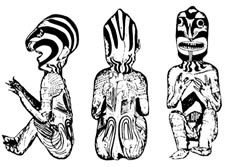 |
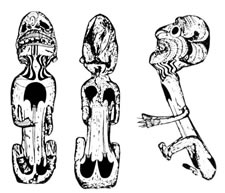
|
| |
Sketches of fully tattooed tapa figures. From top, a swooping frigate bird is tattooed on the back above the buttocks (center view) and is symbolic of war and headhunting. From bottom, 'ao or mata'a motifs on torso and back are suggestive of warfare and/or ancestral protection. Feather-like tattoos appear on the neck and three lines adorn the chin. |
On Easter Island, tattoo was widespread and often associated with chiefly or warrior status. The face, neck, torso, back, legs, arms, and top of the head were tattooed and Rapa Nuitattooing implements (ta kona) were similar to those found elsewhere in Polynesia: a comb of bird bone lashed at a right angle to a wood handle. The comb was dipped in a prepared pigment of charred ti leaves (Cordyline terminalis) mixed with black nightshade (Solanum nigrum) juice and struck with a mallet into the skin. In Hawaii, ti was considered sacred to the god Lono and to the goddess Laka. Ti leaves were emblems of high rank and divine power and they were carried to ward off evil spirits and bring good fortune.
The Vanishing Rapa Nui Tattoo
Sadly, there is very little pictorial evidence of Rapa Nuitattooing today. In fact, just a handful of photographs survive of traditional Rapa Nuitattooing, and only one of male tattooing itself. This 1870s postcard, shot by Tahitian photographer Madame Hoare, portrays Juan Tepano, a Rapa Nuinobleman, with neck and facial tattoos. The Swedish ethnographer Hjalmar Stolpe who traveled the Pacific in the 1880s also illustrated Tepano in portrait and profile views, but by 1911 only four islanders out of 228 wore traditional tattoos, and these were women. By 1930, only two tattooed women survived: Juan Tepano’s mother, old Viriamo, and Ana Eva Hei, the wife of Atamu Te Kena, one of the last “kings” of Easter Island. Both women were incompletely tattooed and Viriamo said she refused to submit to further sittings because the tattooing operation was too painful. Ana Eva Hei, who was younger, was tattooed by one of the last "experts".
As in most of Polynesia, tattoo artists were men and on Rapa Nui they were specialists - like wood and rock carvers - and their work was supervised by the ariki mau, or ruling king. Being maori ("expert"), tattooists constituted a class of tufunga, or a kind of priesthood or guild, "charged" with sacredness because they had mastered their ritual craft. Certainly tattooists, as members of the tufunga brotherhoods, worked under strict religious codes that dominated their respective professions. Because as one early visitor noted, tufunga were exempt from performing any laborious activity not associated with their work, indicating their high status in the eyes of the local community.
Symbolic Dimensions of Women's Tattooing
Generally speaking, Rapa Nuitattoo was comprised of fundamental motifs preserved and passed from one generation to the next. It is true, however, that personal taste varied and perhaps different clans had favorite designs, but little else is known of the symbolic import of tattooing: except that certain designs were more common than others.
Women and men very often had heavy lines on their faces which crossed their foreheads or extended from one ear to the other. These lines were curved and combined with a series of large dots (humu or puraki) that marked the forehead and temples. These designs are also seen on existing barkcloth figures, but in smaller detail.
On the cheeks of women below the ears was a motif called pagaha’a, "something that hangs heavy", formed by the meeting of two designs, one triangular and the other fusiform (tapering at each end). An old spelling of this word is tangehua or pangehúa, and based on the root hua, it can be suggested thatthese were fertility markings: hua means “testicle,” or more figuratively, “son”. Other motifs included tattooed rings (ngutu tika) surrounding the mouth of women, possibly akin to the Maoritattoo custom, and three vertical lines descending the mouth sometimes crossing the chin.
On the back of old Viriamo, between the shoulder blades, is a motif called ‘ao ("dance paddle") with conventionalized eyes and nose. When interviewed Viriamo in 1911, she said she received her ‘aotorso markings "after [her] first sexual intercourse." 'Ao dance paddles resemble a vagina in abstract form and the elongated V-shaped curves that comprise their "face" may symbolize the former female custom of artificially extending the clitoris. |
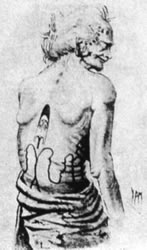 |
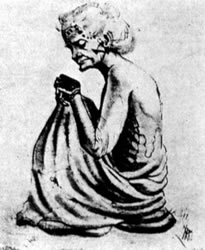
|
Back and profile view of Old Viriamo, Tepano's mother, 1911. |
Notwithstanding these considerations, along the lower part of Viriamo's back under the tattooed ‘ao is a stripe which winds back and forth. These bands, or “dancing torsos”, are tattooed in one continuous design around the body. On one barkcloth figure, the same tattoo design covers the buttocks and the waist region, and the band terminates at a bird design with a beak joined by two concentric rings.
It is possible that the ‘ao motifs have an ancestral and protective importance, especially since the word ‘ao also refers to the ruling elite, suggesting that only aristocrats - who were closer to the gods - could wear these tattoo motifs. However, the ‘aodesigns perhaps have a deeper symbolic significance. In 1770, Spanish explorers to Easter Island noted that a pair of tattoos called pare marked the abdomen. Another writer gave the name pare-pu to the anthropomorphic tattoos on the abdomen of a female informant, which raises some issue over what was ‘aoand what was pare? The Swiss anthropologist Alfred Métraux recorded that the word pare was given to him as meaning a motif tattooed around the waist, one that I would suggest was similar to that which Viriamo wore on her torso.
Gleaning linguistic evidence from Rapa Nuidictionaries, pare is an obsolete word, meaning “a kind of sculpture made of wood” or “tattooing on the arms.” Maori dictionaries state that pare is “a wooden figurine representing a human head with arms.”
Thus, it at least seems clear that some sort of affinity existed between particular forms of Easter Island tattooing and woodcarving. Looking towards New Zealand, the same pattern follows since the culture hero Mataoraintroduced tattooing and wood carving to the Maori. More specifically, the Maorimaintained a rich tradition of wood carving and one particular form, called pare, adorned the lintel above the entrance door of the house. Of course, as Easter Island became devoid of trees circa 1850-1900, we can be fairly certain that even before that time large pieces of wood were scarce, and certainly those needed to carve lintels must have been rarer still. Indeed, we have no archaeological evidence that this custom was ever practiced on Rapa Nui, although carved wooden images of lizards (moko), possibly in the form of clubs, stood on either side of doorways to ward-off intruders or to protect the dwellers of the house against evil spirits. For the Maori, lizards were symbolic of death and it was necessary to employ a ritual specialist to avert their evil omen.
The art historian Michael Jackson has commented extensively on the “symbolic system” of Maori pare, where “[t]here seems little doubt that the pare composition reveals a symbolic connection with the Maori conception of birth and death, creation and dissolution.” For example, over the door of the Maorihouse, female genitalia were carved in deep relief on pare lintels, sometimes with a small stylized anthropomorphic head being situated in place of the genitalia suggesting parturition. In Maorimythology, the vagina symbolized destructive energy because of its association with the po and the residual sacredness (tapu)that emanated from newborns into the world. Thus crossing the threshold of the Maorihouse brought an individual dangerously close to the great mana contained and displayed within it. In this sense, pare sculptures exemplify a double-sided function whereby the female, who has the contagious power (tapu) to transform life by destroying it and also by recreating it (by giving birth), symbolizes the fundamental division of the Maorimythological universe; one that is displayed in the carved lintel, which by surmounting the dwelling house, embodies all social life within and outside of its door.
Similarly, the mouth tattoos of Maoriand Rapa Nuiwomen may also evoke this cosmological relationship. Waha, the Maoriword for mouth, also referred to the vagina, and the tattooed mouth ring of Rapa Nuiwomen, called ngutu tika, or "mouth marking," probably embodied similar concepts, although a related term ngutu tiko translates to "menstrual opening." Because it is the death and rebirth of symbolic forms that is at the essence of our inquiry, it is obvious that menstrual blood is highly tapu while at the same time it refers to the potentiality of creating life. |
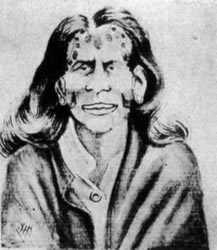 |
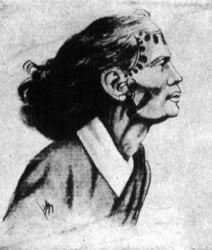
|
Profile and portrait views of Ana Eva Hei, 1911. Note her tattooed mouth ring, |
Curiously, the main facial tattooing of Maori women besides the labial markings placed around the mouth were chin markings called whakatehe, from “tehe”, “the penis in an erect state”. Although the term for these tattoos has been forgotten on Easter Island, the chin was crossed by three vertical stripes descending from the mouth. If we are to read the female mouth/chin-tattoo as a manifestation of the phallus probing towards its predestined (open) orifice, a view proposed by the late anthropologist Alfred Gell, then I would suggest that this form of tattoo was perhaps conceived of as a kind of fertility symbol.
Men's Tattoo Motifs
| |
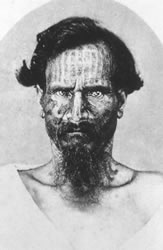 |
|
Carte de visite of the Rapa Nui
nobleman Juan Tepano, 1870s.
|
Besides the tattooing which was done for women, however, many elaborate and symbolic forms were received by Rapa Nuimen. Juan Tepano, Viriamo’s son, wore forehead tattoos (retu, “to stand”) consisting of six to ten solid vertical stripes. The parallel lines across the top of the forehead and the fringe of dots around his hairline were the first motifs tattooed on the face. This pattern was the most general, since it was the one commonly recorded by early voyagers.
But of considerable interest are the tattoos that you cannot see. Beneath Tepano’s chin and beard (on the throat) is a stylized bird with head turned down, elongated body and wings reduced to four small tattoo lines. This motif, also seen in other abstract versions on barkcloth figures, is that of the frigate bird. The frigate, a predatory bird that flies swiftly and cunningly, is widely associated with the tattoo traditions of several indigenous peoples of Polynesia, Melanesia, and Indonesia, and is symbolic of headhunting and warfare. Although rarely seen on Easter Island today, frigates acquired a special mystique as a symbol of invasion and aggression. They were a symbol of the warrior class who overthrew the ruling nobility during the Decadent Period (1500-1722 A.D.): a time when Rapa Nuiwas characterized by intertribal warfare, cannibalism, and the disintegration of society.
Tepano’s other tattoos reinforce this avian symbolism. On the right side of his spine is a set of nine parallel lines, running vertically and bending to the right at the bottom, reminiscent of a bird swooping downwards with wings outstretched. The fundamental decoration of the neck (ua), which was essentially masculine, consisted of four pairs of broad and wavy stripes. Also appearing on large stone moai around the island, these tattoos look like bird feathers, and when combined with Tepano’s other markings they transformed him into a powerful predatory “birdman.”
| |
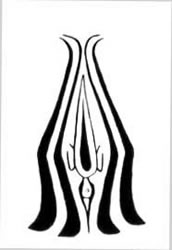 |
|
Stylistic frigate bird tattoo appearing
on Tepano's throat, 1880s.
|
As early as the fifteenth century, a series of annual religious ceremonies developed on Rapa Nuithat were centered on the creator god Makemake, whose earthly manifestation was the tangata manu or birdman. The rise of the cult of Makemake marked a radical shift from the old religion of ancestor worship and seems to have evolved from a postulated earlier bird ritual that arose in response to the warrior class’s need to justify and legitimize its anarchistic rule over the secular and declining authority of the ruling elite. Born from a floating skull that was washed from a temple into the sea, Makemakecreated the first humans and with his companion, the goddess Haua, brought the first flocks of migratory seabirds to the island.
The continuous cycle of war that plagued Rapa Nuiduring the Decadent Period has been supported by archaeological findings: obsidian spearpoints (mata’a) have been uncovered in large quantities. Likewise human bones that display cut marks have been unearthed suggesting cannibalism.
For the Maoriof New Zealand, warfare was also endemic and provided a constant source of terrifying reality. The concept of death among the Maoriwas called mate. Mate is also the Rapa Nuiword for death and the derivative mata’a means a spearhead made of obsidian in both the Maoriand Rapa Nuilanguages. Interestingly, mata’a appear on two of the barkcloth figures from Easter Island suggesting in all likelihood that they were a traditional tattoo motif of the matatoa – the warrior class.
Next Page | 1 | 2 | 3 | 4 | 5 | 6 | 7 | 8 |
Museum photo gallery of the images
on this page may be seen here. |










